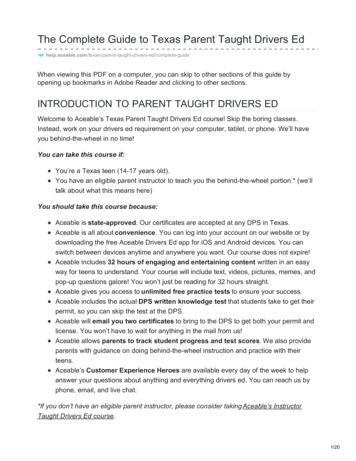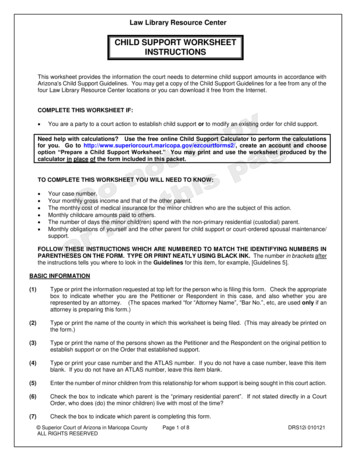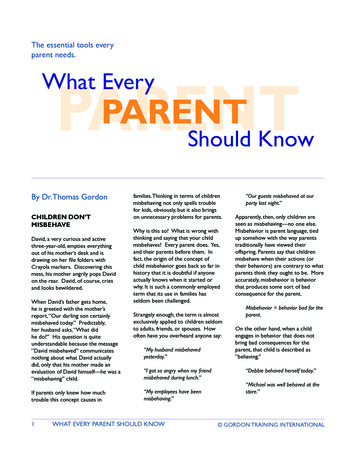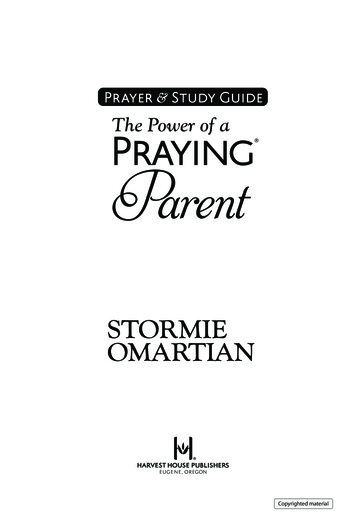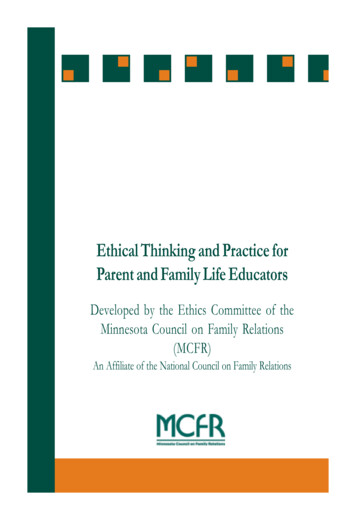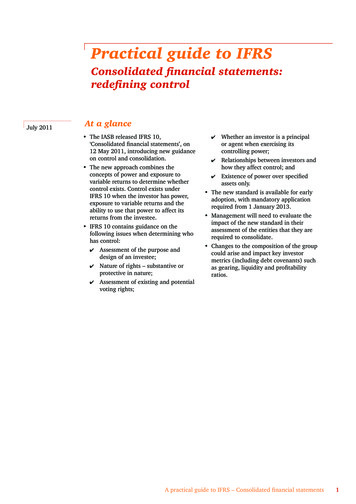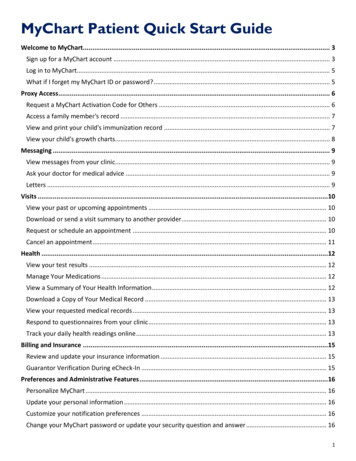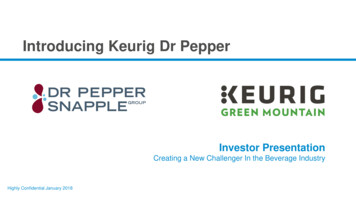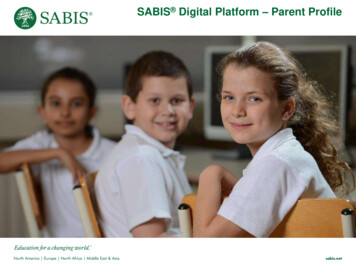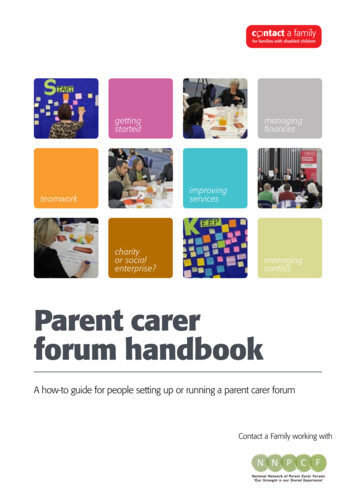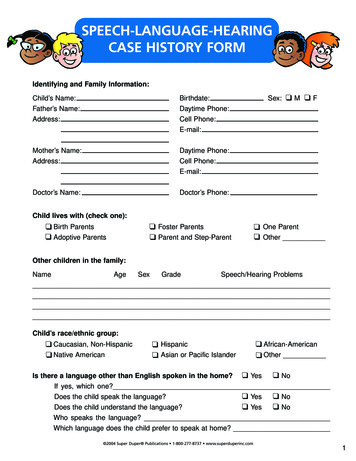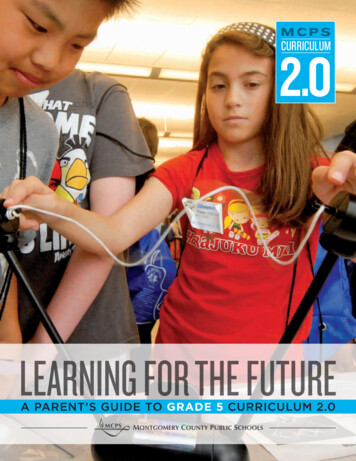
Transcription
MCPSLEARNING FOR THE FUTUREA PARENT’S GUIDE TO GRADE 5 CURRICULUM 2.0
BOARD OF EDUCATIONMrs. Patricia B. O’NeillPresidentMr. Michael A. DursoVice PresidentMr. Christopher S. BarclayDr. Judith R. DoccaMr. Philip KauffmanMs. Jill Ortman-FouseMrs. Rebecca SmondrowskiMr. Eric GuerciStudent MemberSCHOOL ADMINISTRATIONMr. Larry A. BowersInterim Superintendentof SchoolsDr. Maria V. NavarroChief Academic OfficerDr. Kimberly A. StathamDeputy Superintendent of School Support a ndImprovementDr. Andrew M. ZuckermanChief Operating OfficerVISIONWe inspire learning by providingthe greatest public education toeach and every student.MISSIONEvery student will have theacademic, creative problem solving,and social emotional skills to besuccessful in college and career.CORE PURPOSEPrepare all students to thrive intheir future.CORE VALUESLearningRelationshipsRespectExcellenceEquity
CURRICULUM 2.0broadens instruction beyond reading and mathematicsto engage the whole child. Ten subject areas at the elementary level—art, healtheducation, information literacy, mathematics, music, physical education, reading,science, social studies, and writing—have been refocused around the critical andcreative thinking and academic success skills students need for a lifetime oflearning. There are four major features of Curriculum 2.0:Internationally driven standards in mathematics, reading, andwriting: Mathematics, reading, and writing are based on the rigorousCommon Core State Standards (CCSS). These standards, adopted byMaryland in June 2010, describe the content that students must learnat each grade level and are designed to help U.S. students competefavorably with students around the world.A focus on teaching the whole child: The curriculum provides moreinstructional focus on subjects such as the arts, information literacy,physical education, science, and social studies by blending them withmathematics, reading, and writing. Students will receive instruction acrossall subjects in elementary school.Integrated thinking, reasoning, and creativity: The integration of thinkingand academic success skills—or those skills that contribute to students’ability to creatively solve problems collaboratively, interpret multiple perspectives, analyze complex data,and understand connections among a variety of ideas—is the unique aspect of Curriculum 2.0. Theseskills have been identified in the educational research as the tools necessary to thrive in the 21st centuryknowledge-based global economy.Communication of student progress through a “standards-based” report card: The elementary schoolreport card is aligned with the concepts and topics taught in Curriculum 2.0 each marking period. Thequarterly report card provides feedback to students and parents throughout the year about how wellstudents are meeting academic standards compared with grade-level expectations.Curriculum 2.0 deeply engages students and helps them develop the skills they need to thrive in schooland beyond.MCPS CURRICULUM 2.03
THINKING AND ACADEMIC SUCCESS SKILLSStudents who thrive academically, socially, and emotionally know more than just facts.They have a certain set of skills that enable them to learn and succeed in almostany environment. These include critical thinking, creative thinking, and academicsuccess skills. The chart on the right describes the thinking and academic successskills that are integrated throughout Curriculum 2.0 as students progress throughelementary school.4CURRICULUM 2.0 GRADE 5
ICSUCCESS SKILLSCritical thinking involves beingobjective and open-mindedwhile thinking carefully aboutwhat to do or what to believe,based on evidence and reason.Creative thinking involvesputting facts, concepts, andprinciples together in new waysand demonstrating a novel wayof seeing or doing things.Academic success involvespossessing attitudes andbehaviors that enable studentsto reach their full potential inacademic settings.AnalysisElaborationCollaboration N oticing what’s alike andwhat’s different I ncluding descriptive detailsin your writing, conversations,and art work R especting the ideas ofothers D escribing what parts makeup a whole Looking for patterns E xplaining something exactlyhow it happened takes time A sking other people whatthey think S eeing how things fittogether Explaining your thinking W orking with others toaccomplish a goal or taskFlexibility Sorting objects K nowing how to lead a groupand be a member of a groupEvaluation C onsidering the ideasand thoughts of others Q uestioning facts and claims,including your own Q uestioning answersyou’re given C hallenging yourself toaccomplish difficult tasks Demanding evidence Asking “why” questions C hecking the reliability ofinformation you’re viewingor reading C hanging your thinkingbased on evidence ornew ideas T hinking of additional waysto reach your goal whenthings get difficult K nowing what to do whentwo sources of informationconflictFluency R anking options based oncriteriaSynthesis E xpressing your ideas orthoughts by writing,drawing, talking, or acting P utting things back togetherafter taking them apart S howing the same thingin many ways S eeing how new ideas comefrom other ideas K nowing many ways toanswer a question M aking something new outof the parts you already haveOriginality C hallenging yourself torise to the next level C reating new ideas andproductsMetacognition—Thinkingabout Thinking E xplaining your answers innew and inventive ways T hinking about what youalready know about a topicbefore learning more Organizing your thoughts C oming up with manynew ideas T urning ideas and products ofothers into something new S eeing problems as achance to solve somethingin a new wayEffort/Motivation/Persistence N ever giving up. Asking forhelp when learning is difficultIntellectual Risk Taking A sking questions to help youunderstand—every day S haring what you’rethinking in a group S haring your ideas andanswering questions, evenwhen you’re unsure N oticing the ways you learnbest and asking for helpwhen you’re struggling Explaining your thinkingMCPS CURRICULUM 2.05
for creativity aims to encourage“ Teachingself-confidence, independence of mind,and the capacity to think for oneself.”Sir Ken Robinson, Out of Our Minds: Learning to be CreativeIN CURRICULUM 2.0, GRADE 5, specific critical and creative thinking andacademic success skills are identified for each marking period. These skillsare explicitly taught through the concepts and topics in the 10 contentareas and provide a focus for integration across subjects.ArtPhysical EducationGeneral MusicReading/Language ArtsHealth EducationScience, Technology, and EngineeringInformation LiteracySocial StudiesMathematicsWritingThe following pages highlight the critical thinking, creative thinking, andacademic success skills along with the curriculum concepts and topics thatare the focus of instruction in each marking period for Grade 5 students.Curriculum 2.0 is built around developing students’ criticaland creative thinking skills, as well as essential academicsuccess skills, which will lead to college and career readinessin the 21st century.MCPS CURRICULUM 2.07
MARKING PERIOD 1Bulleted concepts in red are graded on the report card for Marking Period 1.Flexibility(Creative Thinking Skill)—Being open andresponsive to new and diverse ideas and strategies andmoving freely among them. Demonstrate adaptability by changing ideas, questions,resources, or strategies when presented with evidence.Collaboration(Academic Success Skill)—Workingeffectively and respectfully to reach a group goal. Solicit and respect multiple and diverse perspectives tobroaden and deepen understanding. Identify and analyze options for sharing responsibility toreach a group goal. Support group decisions with criteria.SOCIAL STUDIESREADING/LANGUAGE ARTS Literature: Adventure, traditional stories; comparison of texts inthe same genre, characters, settings, or events; explanation ofplot structure; narrator or speaker’s point of view; contributionof multimedia elements to text; themes in literature; use ofquotes when making inferences; use of academic vocabulary. Informational Text: Literary nonfiction—biography; use ofquotes when making inferences; analysis of multiple accountson same topic noting point of view; main idea and key details;explain relationships among individuals, events, ideas, orconcepts; integration of information from texts on same topic;comparison of structure in texts; use of print or digital resourcesto locate information. Language/Vocabulary: Collaborative discussions to deepenmeaning; use of academic and content-specific vocabulary;clarification of figurative language, homographs, and wordrelationships; summary of speaker’s point of view; use of printand digital reference materials; summary of oral and visualinformation. Economics: Economic systems in colonial America; Britisheconomic policies in the American colonies; impacts andchallenges of becoming a new nation. History: American Revolutionary War period – interactionbetween American colonists and Britain; roles and viewpoints ofindividuals and groups; key events. Culture: Conflict and compromises.WRITING Informative/Explanatory: Extended writing—group relatedinformation logically; link ideas; use domain-specific vocabularyto develop a topic; incorporate text features; include examplesrelated to the topic; draw a conclusion. Narrative: Short composition—establish a situation; describe anddevelop character’s response to events using descriptive details;sequence events using transitional words; conclude events.SCIENCE, TECHNOLOGY, AND ENGINEERING Physical Sciences: Motion of objects—distance, time, direction,speed; changes in motion—force, mass; energy and motion—potential, kinetic; conversion of energy. Engineering and Technology: Characteristics and scope oftechnology; engineering design process.8CURRICULUM 2.0 GRADE 5 Opinion: Extended writing—introduce the topic; provide logicallyordered reasons supported with facts and details; link ideas withphrases and clauses; summarize an opinion in conclusion. Process, Production, and Research: Organize ideas from severalsources, plan, revise, edit writing; use technology tools to createa presentation for diverse audiences. Use of Language: Conventions of standard English; edit for verbtenses; compare formal and informal English; use commas andpunctuation to separate items in a series; add interjections;consult references; expand, combine, and reduce sentences;report on a topic using multimedia components; adapt speechto a variety of contexts.
FLEXIBILITY AND COLLABORATIONMATHEMATICS Measurement and Data: Develop and apply volume formulas forrectangular prisms. Number and Operations in Base Ten: Fluently multiplymulti-digit whole numbers using the standard algorithm;use rectangular arrays, area models, equations, place valuestrategies, and properties of operations to divide a 2- or 3-digitnumber by a 2-digit multiple of 10; identify and apply patternsamong places in the base ten system including decimals tothousandths; read, write, round, and compare decimals tothousandths; use concrete models, drawings, written methods,place value strategies, and properties of operations to add andsubtract decimals to hundredths. Operations and Algebraic Thinking: Write, interpret, andevaluate numerical expressions with grouping symbols.GENERAL MUSIC Analyzing and Responding to Music: Identify instruments bysight and sound; connections between music and historicalevents; conducting in various meters; audience behaviors. Performing Music: Vocal technique —diction and expression;chordal accompaniment; songs and dances of various periodsand cultures. Reading and Notating Music: Reading simple melodies.HEALTH EDUCATIONMental and Emotional Health Demonstrate healthy communication skills. Analyze how one of the six components of personal well-beingcan be applied to develop goals for positive self-change. Dramatize using the 5 steps in decisionmaking to addresspersonal issues and problems. Demonstrate using time management to reduce stress in avariety of situations.ARTAlcohol, Tobacco, and Other Drugs Describe safe practices for using prescription and over-thecounter drugs based on the drug facts label. Analyzing and Responding to Art/Creating Art: Safety andresponsibility in art class; composition and theme; artists’style—expression and human experience; evaluation of artwork. Analyze internal, external, and media influences to use and notuse alcohol, tobacco, and marijuana.INFORMATION LITERACYPHYSICAL EDUCATION Movement Skills and Concepts: Dribbles, perform bounceand chest passes, shoot toward a target with hands; dribblingpassing, shoot toward targets with feet. Health Enhancing Physical Fitness and Activity: Cardiorespiratory endurance; measure heart rate; resting heart rate;target heart rate; maximum heart rate; muscular endurancevs. muscular strength; flexibility; anatomy of the body—majormuscles; differentiation between aerobic and anaerobic activity;static and dynamic stretching. Inquiry process: Develop and refine researchable questions. Resource identification and location: Search strategies for print,digital, and multimedia resources. Source evaluation: Currency, authority, bias, and defense ofchoices. Note taking: Use technology tools to organize content. Information analysis and synthesis: Interpretations; fact andopinion; point of view; defense of conclusions. Product development and evaluation: Design and format fordiverse audiences; technology presentations; use feedback toreflect on contributing to a learning community. Intellectual property: Citation information; create list of sources. Literature appreciation: Selection and connections to personaland academic pursuits.MCPS CURRICULUM 2.09
MARKING PERIOD 2Bulleted concepts in blue are graded on the report card for Marking Period 2.Synthesis(Critical Thinking Skill)—Putting partstogether to build understanding of a whole concept or toform a new or unique whole. I ntegrate ideas, information, and theories to invent ordevise a solution. Formulate generalizations by examining parts and puttingthem together.Metacognition(Academic Success Skill)—Knowing and being aware of one’s own thinking and havingthe ability to monitor and evaluate one’s own thinking. Self-monitor strategies to assess progress and apply newthinking. Seek clarification and adapt strategies to attain learningtask/outcome.READING/LANGUAGE ARTS Literature: Traditional stories and mysteries; Junior Great Books;comparison of texts in the same genre, characters, settings, orevents; explanation of plot structure; narrator or speaker’s pointof view; contribution of multimedia elements to text; themesin literature; use of quotes when making inferences; use ofacademic vocabulary. Informational Text: Literary non-fiction; use of quotes whenmaking inferences; analysis of multiple accounts on sametopic noting point of view; main idea and key details; explainrelationships among individuals, events, ideas, or concepts;integration of information from texts on same topic; comparisonof structure in texts; use of print or digital resources to locateinformation. Language/Vocabulary: Collaborative discussions to deepenmeaning; use of academic and content-specific vocabulary;clarification of figurative language, word relationships; summaryof speaker’s point of view; use of print and digital referencematerials; summary of oral and visual information; Greek andLatin affixes and roots.SOCIAL STUDIES Civics: Articles of Confederation; United States Constitution;the Bill of Rights; civic participation today; rights andresponsibilities today. History: Effects of the American Revolution; changes in colonialand national governments Culture: Conflicts and compromises; changes in the UnitedStates government; the Constitutional Convention.WRITING Informative/Explanatory: Extended writing—group relatedinformation logically; link ideas; use domain-specific vocabularyto develop a topic; include examples, quotations, facts, anddefinitions related to the topic; draw a conclusion, link ideasusing words, phrases or clauses. Narrative: Short composition—introduce a narrator; use dialogue,description and pacing to develop a clear event sequence;conclude events.SCIENCE, TECHNOLOGY, AND ENGINEERING Physical Sciences: Static electricity; electrical energy—circuits,conduction; magnetism—magnetic forces; forces—wave energy;electromagnets. Engineering and Technology: Characteristics and scope oftechnology; engineering design process.10CURRICULUM 2.0 GRADE 5 Opinion: Short composition—introduce the topic; support reasonswith facts and details; link opinions and reasons with phrases andclauses; draw conclusions. Process, Production, and Research: Organize ideas from severalsources, plan, revise, edit writing; use technology tools to createa presentation for diverse audiences. Use of Language: Conventions of standard English; edit forconjunctions; consult references; expand, combine, and reducesentences; speak clearly at an understandable pace; report on atopic using multimedia components.
SYNTHESIS AND METACOGNITIONMATHEMATICSGENERAL MUSIC Number and Operations in Base Ten: Use rectangular arrays,area models, equations, place value strategies, and propertiesof operations to divide a up to a 4-digit number by a 2-digitnumber. Analyzing and Responding to Music: Describe musical form;describe songs and dances of various periods and cultures;identify major and minor modes. Number and Operations–Fractions: Use equivalent fractions asa strategy to add and subtract fractions; solve word problemsinvolving addition and subtraction of fractions; solve word Performing Music: Vocal technique—diction and expression;partner songs and descants; chordal accompaniment. Creating Music: Music arranging.problems involving multiplication of fractions and wholenumbers with whole number products.HEALTH EDUCATIONART Analyzing and Responding to Art/Creating Art: Ideadevelopment—media experimentation and aesthetic qualities;art and human experience—different times and places,expression of thoughts and feelings; connections between artand other contents; criteria for judging art.Personal and Consumer Health Consider the importance of human needs, personal valuesystems, and assuming responsibility for personal wellness. Discuss strategies to obtain health care help within a schoolsetting.Safety and Injury Define poisons and inhalants, as preventable health risks. Self-monitor thinking to develop personal reasons to say no tosituations that may be unsafe. Discuss how sexual harassment can affect personal well-being.PHYSICAL EDUCATION Movement Skills and Concepts: Overhand throw and catch;strike with body parts. Personal and Social Responsibility: Goal setting; establish,monitor, and modify a personal physical activity goal.INFORMATION LITERACY Inquiry process: Develop and revise questions based onresources. Resource identification and location: Search strategies for print,digital, and multimedia resources. Source evaluation: Currency, relevance, defense of choices. Note taking: Use technology tools to organize content. Information analysis and synthesis: Revision of questions;summarize and paraphrase different interpretations; relevanceand completeness. Product development and evaluation: Develop design criteria fordiverse audiences; create and revise technology presentations. Intellectual property: Citation information; create list of sources. Literature appreciation: Defense of literature choices andintellectual freedom.MCPS CURRICULUM 2.011
MARKING PERIOD 3Bulleted concepts in green are graded on the report card for Marking Period 3.Elaboration(Creative Thinking Skill)—Adding detailsthat expand, enrich, or embellish. Combine or add to thoughts, ideas, processes, or products.Intellectual Risk Taking(Academic SuccessSkill)—Accepting uncertainly or challenging the norm toreach a goal. Adapt and make adjustments to meet challenges whenseeking solutions. Demonstrate willingness to accept uncertainty by sharingideas, asking questions, or attempting novel tasks. Challenge self and others to advance skill level.READING/LANGUAGE ARTS Literature: Poetry, realistic fiction, Junior Great Books;comparison of texts in the same genre, characters, settings, orevents; explanation of plot structure; narrator or speaker’s pointof view; contribution of multimedia elements to text; themes inpoetry; use of quotes when making inferences; use of academicvocabulary. Informational Text: Literary non-fiction—graphic novels;explanation of events, procedures, or concepts in a text;interpretation of visual and oral information; use of text evidencewhen making inferences; main idea and key details; descriptionof text organization; use of academic vocabulary; integration ofinformation from two texts; author’s use of reasons and evidenceto support points.SOCIAL STUDIES Geography: Geographic characteristics of the United States;population growth, migration, and settlement patterns inthe United States; territorial expansion to the AppalachianMountains; territorial expansion to the Mississippi River;territorial expansion to the Pacific Ocean. Language/Vocabulary: Collaborative discussions to deepenmeaning; use of academic and content-specific vocabulary;clarification of figurative language, homographs, and wordrelationships; summary of speaker’s point of view; use of printand digital reference materials; summary of oral and visualinformation; Greek and Latin affixes and roots. History: Changes in industry, transportation, education andrights in the 1800s.WRITING Informative/Explanatory: Short composition—determine a textstructure such as description; link ideas; include examples andquotations related to the topic; draw a conclusion.SCIENCE, TECHNOLOGY, AND ENGINEERING Earth and Space Sciences: Astronomy—celestial patterns,light and shadow; properties and patterns of Earth and stars;Earth’s relationship to the sun; characteristics of Earth andother planets; characteristics of other celestial bodies—comets,asteroids, meteors, moon. Physical Sciences: Wave energy—light; properties of light—pathways and interactions with materials. Engineering and Technology: Impact of products and systems;influence and impact of space exploration on technology.12CURRICULUM 2.0 GRADE 5 Narrative: Extended writing—establish a situation; describe anddevelop character’s response to events using descriptive details;sequence events using transitional words, phrases, and clauses;conclude events. Opinion: Short composition—introduce the topic; providelogically ordered reasons supported with facts and details;link ideas with phrases and clauses; summarize an opinion inconclusion. Process, Production, and Research: Organize ideas from severalsources, plan, revise, edit writing; use technology tools to createa presentation for diverse audiences. Use of Language: Conventions of standard English; edit forpresent tense; consult references; recall experiences usingmultimedia components.
ELABORATION AND INTELLECTUAL RISK TAKING MATHEMATICS Numbers and Operations–Fractions: Use equations, areamodels, and number line models to multiply a whole numberor a fraction by a fraction, including mixed numbers; interpretmultiplication as resizing; apply and extending previousunderstandings to divide unit fractions by whole numbers andwhole numbers by unit fractions; interpret fractions as divisionof numerator by denominator; solve word problems involvingmultiplication and division of fractions.GENERAL MUSIC Analyzing and Responding to Music: Connections betweenmusic and other arts; describing songs and dances of variousperiods and cultures; identifying differences in performances;moving to communicate meaning or feeling in music. Reading and Notating Music: Music reading—melodic; musicnotation—melodic. Creating Music: Improvisation with instruments. Measurement and Data: Solve measurement problems involvingline plots.HEALTH EDUCATIONART A nalyzing and Responding to Art/Creating Art: Theme—expression of personal stories and feelings; criteria for judgingart; representation of what is observed.PHYSICAL EDUCATION Movement Skills and Concepts: Creative dance (sequence,rhythm, formation, and coordinating movement with others)meet and part; unison and contrast; mirror and match; advancedtumbling sequences (balance, weight transfer, and roll). Personal and Social Responsibility: Conflict resolution (voiceyour opinion, listen to others, compromise, get help).Nutrition and Fitness Discuss input as calories or energy consumed and outputas calories used by the body during physical activity andmovement. Discuss factors that affect eating habits. Use the Dietary Guidelines for Americans and ChooseMyPlate.gov to develop healthy snack choices.Family Life and Human Sexuality Restricted lessons that discuss puberty, maturation, andchanging attitudes of adolescents.INFORMATION LITERACY Inquiry process: Develop and revise questions based onresources. Resource identification and location: Search strategies for print,digital, and multimedia resources. Source evaluation: Currency and relevance. Note taking: Use technology tools to organize content. Information analysis and synthesis: Revision of questions;location of additional information. Product development and evaluation: Develop design criteria fordiverse audiences; use feedback to reflect on contributing to alearning community. Intellectual property: Citation information; create list of sources;fair use and Creative Commons. Literature appreciation: Selection and connections to personaland academic pursuits.MCPS CURRICULUM 2.013
MARKING PERIOD 4Bulleted concepts in yellow are graded on the report card for Marking Period 4.Evaluation(Critical Thinking Skill)—Weighingevidence, examining claims, and questioning facts to makejudgments based upon criteria. Justify a choice or solution based on criteria using evidenceand reason. Question facts and claims. Determine the credibility of information and claims. Determine how to use conflicting Success Skill)—Working diligently and applying effectivestrategies to achieve a goal or solve a problem; continuingin the face of obstacles and competing pressures. Identify the components of goal-setting. Develop and demonstrate a sequenced program of actionto achieve a goal or solve a problem.READING/LANGUAGE ARTS Literature: Plays, poetry; comparison of genres; use of textevidence when making inferences; differences between poems,drama, and prose; comparison of themes in two texts; use ofacademic language; comparison of narrators’ points of view. Informational Text: Information presented in diverse formats—articles, poetry, Junior Great Books, video, etc.; use of quoteswhen making inferences; analysis of multiple accounts on sametopic noting point of view; main idea and key details; explainrelationships among individuals, events, ideas, or concepts;integration of information from texts on same topic; comparisonof structure in texts; use of print or digital resources to locateinformation. Language/Vocabulary: Collaborative discussions to deepenmeaning; use of academic and content-specific vocabulary;clarification of figurative language and word relationships;summary of speaker’s point of view; use of print and digitalreference materials; summary of oral and visual information.SOCIAL STUDIES Economics: Goods and services produced in Maryland—pastand present; technological changes—impacts on consumersand businesses, the global market; careers; financial decisionmaking—spending, saving, investing, sharing; debt and credit.WRITING Informative/Explanatory: Extended writing—group relatedinformation logically; link ideas with phrases and clauses, focuson a topic; use domain-specific vocabulary to develop a topic;incorporate text features; include examples related to the topic;draw a conclusion.SCIENCE, TECHNOLOGY, AND ENGINEERING L ife Sciences: Multicellular organisms—plant and animal cells,specialized cells; unicellular organisms; heredity—inheritanceand variation of traits in plants and animals. Engineering and Technology: Development, impact and use oftechnology—microscopes, troubleshooting. Opinion: Extended writing—introduce an opinion; providelogically ordered reasons supported with facts and details;link ideas with phrases and clauses; summarize an opinion inconclusion. Process, Production, Research: Organize ideas from severalsources, plan, revise, edit writing; use technology tools to createa presentation for diverse audiences. Use of Language: Conventions of standard English; edit forcorrelative conjunctions; consult references; report on a topicusing multimedia components. Narrative: Short composition—compose a clear event sequenceusing sensory and descriptive details; use transitional phrasesand clauses, provide closure based on events.14CURRICULUM 2.0 GRADE 5
EVALUATION AND EFFORT/MOTIVATION/PERSISTENCE MATHEMATICSGENERAL MUSIC Measurement and Data: Solve multi-step word problemsinvolving conversion of measurement units. Creating Music: Composition and music notation of originalmelodies; improvising with instruments; improvising with thevoice. Number and Operations in Base Ten: Use concrete models,drawings, written methods, place value strategies, andproperties of operations to multiply and divide decimals tohundredths. Geometry: Graph points on a coordinate plane; classify twodimensional figures in a hierarchy based on properties. Reading and Notating Music: Music reading—melodic. Performing Music: Vocal technique; performing partner songsand descants; ensemble performance; diction and expression;playing technique—world instr
new ideas Fluency Coming up with many new ideas Expressing your ideas or thoughts by writing, drawing, talking, or acting Showing the same thing in many ways Knowing many ways to answer a question Originality Creating new ideas and products Explaining your answers in new and inventive ways Turning ideas and products of
